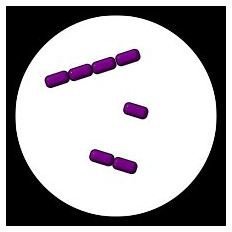Study Guide for Bacterial Cell Structure: Shape, Size and Arrangement of Bacteria
Overview of Microorganisms and Bacteria
Microbiology is the study of ever-present minute living organisms visible only under a microscope. One of the important topics in microbiology is learning about the bacteria (bacteriology). I bet that when you were just in your toddler stage, your first teachers about bacteria were your parents. When you were small and about to place a toy or your hand in your mouth, parents rushed and said, “No! Germs!” - that’s your first lesson because parents simply understand that germs or harmful microorganisms can cause disease. Microorganisms such as bacteria that can cause disease are known as pathogenic and those that are harmless are considered as non-pathogenic microorganisms.
Bacteria are one-celled microorganisms or unicellular microscopic living organisms. They are the smallest organisms which have all the needed protoplasmic equipment for self-multiplication and growth. They are classified as prokaryotes because the cell does not contain a nucleus.
Bacteria are naturally everywhere: in the water we drink; air we breathe; in our skin; and inside our body. However, they are not visible to the naked eye. Tiny organisms like bacteria can only be examined under a compound light microscope.
The structure or morphology of bacterial cells includes the shape, size and morphological arrangement. The best way to use this study guide is to understand the characteristics by description and be familiar with the visual representations.
Bacterial Cell Morphology
Shape
There are three common shapes of bacteria: Spiral, spherical and rod.
1. Spiral-shaped
-
The Spirochete has a long axis that bends when in motion.
-
Vibrio is a curve-shaped bacteria that looks like a “comma” or a “curl”.

- Spirillum appears similar to the spirochete but its long axis remains rigid when in motion.
2. Spherical
- Coccus or cocci are not perfectly round but may be a bit elongated, flattened on one side or oval

3. Rod-shaped
- Bacillus or bacilli may either be short and plump or long and slender.

Size
- The size of bacteria varies greatly from 0.2 micrometers in diameter for a spherical shaped cell to 10 micrometers in length for a spiral shaped cell.
- Average diameter of coccus is 1 micrometer whereas bacillus is 3 micrometers long and 1 micrometer wide.
- There are also discoveries of unusual sizes of bacteria that are larger and smaller than the mentioned sizes.
Arrangement
Cocci can be seen in four different arrangements.
1. Diplococci - in pairs; Neisseria gonorrhoeae is a typical example of diplococci causing the disease, Gonorrhea.

2. Streptococci - in chains. Streptococcus pyogenes are the cause of strep throat.

3. Staphylococci - in clusters. Boils are caused by Staphylococcus aureus.

4. Tetrad - pack of four cocci. Tetrad rarely cause disease.

5. Octad - pack of eight cocci. Octad is mostly non pathogenic.

Bacilli arrangements include diplobacilli (in pairs) and streptobacilli (in chains)

Memory Tips
To absorb this lesson quickly, read the descriptions and familiarize yourself with the pictures over and over because repetition is one of the best ways of recording information into our memory. If you think that you have mastered it already, test yourself by identifying the pictures and giving the descriptions verbally.
